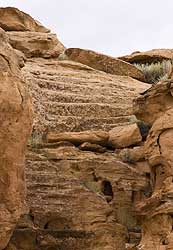The extensive Chacoan road system is impressive. More than 400 miles of prehistoric roadway have been identified. This system connected Chaco to outlying communities and resource areas. It also provided connections between outlying communities. Some segments appear to lack a recognizable destination. One of the longest identifiable road segments of road headed north, leading to the prehistoric communities of Salmon and Aztec.
These roads were not simple trails worn by centuries of foot travel. They were engineered and planned, and represent a significant amount of labor investment in their construction and maintenance. Their function may have been more than utilitarian. There is a growing consensus among archeologists that the road features may directly reflect the pueblo world view.
The most elaborate road construction occurs near the great houses, where double and quadruple road segments have been found. These segments may relate to ritual and ceremony. The prehistoric road system facilitated communication between communities and assisted in the transportation of goods. It also provided a means for bringing the culture together through its relation to the social organization and cosmography of these ancient people.
